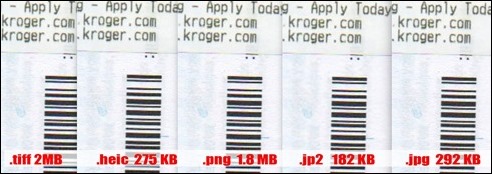Tech Friday: Scanning options – jpg, jpeg, jp2, gif, png, heic, tiff
Posted By RichC on November 20, 2020
It has been a while since I’ve compared scanning format and compression option when it comes to down and dirty document scanning.  For the most part I either scan straight to PDF and live with the document (or shrink it, but that’s another post) … or go straight to the old fashion universal jpeg or jpg (used for the same). Of course the scanner setting have a lot to do with it, but for this test I’m leaving my Epson WF M1560 set exactly how I’ve been using it for a long time now.
For the most part I either scan straight to PDF and live with the document (or shrink it, but that’s another post) … or go straight to the old fashion universal jpeg or jpg (used for the same). Of course the scanner setting have a lot to do with it, but for this test I’m leaving my Epson WF M1560 set exactly how I’ve been using it for a long time now.
The reason the question came up was due to the JPEG 2000 format which offers much better compression (see below). So first the comparison of a scanned receipt at 150 dpi with slight watermarking and the exact sizes of the final scan for each format (that is all that was changed .. the format).
To my eyes at this lower quality quick scan, there is no different is document quality. I’m not sure I’ll change my ways, but I’ll likely continue to use the .PNG for screenshots, the .GIF for animated and where transparency is needed and either my original JPG or possibly JP2 (jpeg 2000) going forward.
Part 1.
JPG vs. JPEG a. What are JPG and JPEG FormatStanding for Joint Photographic Experts Group, JPEG is a raster image file format that uses lossy compression (in the ratio of 10:1 to 20:1) and is used by the digital cameras and other devices. The format is majorly used for storing as well as transmitting images over the net.
Talking about JPG format it is same as JPEG and both the formats can be considered as interchangeable. The major difference in both the formats lies in the number of characters used in their extension. JPEG uses .jpeg (4 characters) as an extension while .jpg uses 3 characters. The original .jpeg extension was cut short to .jpg as the earlier Windows versions (MS-DOS and FAT-16 file systems) supported only a three letter extension for the file.
The limitation for the number of characters in the extension was restricted only to Windows and DOS users while UNIX and the Mac users continued using the .jpeg extension. However, the new versions of the Windows support more characters in their extension but the majority of the people have been used to using the JPG file.
So in nutshell, there is no difference between JPG and JPEG image format. JPG is the outcome of the Windows and DOS limitation, and now is one of the most commonly used formats.
Part 2.
JPEG 2000 Knowledge
a. What is JPEG 2000 format
Developed by Joint Photographic Experts Group in the year 2000, JPEG 2000 (JP2) is an image compression standard, where bitmap image is created using the JPEG 2000 Core Coding. These files can be stored using the lossy or lossless compression as required. When compared to JPEG, JPEG 2000 files uses wavelet compression algorithm while the former uses Digital Cosine Transform compression. JPEG 2000 was created to offer improved compression as well as image quality.
b. The Different Between JPG and JPEG 2000
Though JPEG and JPEG 2000 are proposed by the same company and sound similar but there are a number of differences between the two formats and both of them use a completely different algorithm. JPEG has been in use for a long time, whereas JPEG 2000 has been a recent format and also a better and sophisticated one.
JPEG 2000 is capable of offering lossy as well as lossless compression in the same file stream while only uses the lossy compression. So in terms of quality, JPEG 2000 offers better compression and thus better quality and richer content. The JPEG format is limited to RGB data while JPEG 2000 is capable of handling 256 channels of information. Another major difference between these two formats lies in their capability to offer high compression ratios for lossy compression. A JPEG 2000 file can handle and compress files from 20 to 200 % more as compared to JPEG. Another benefit of using JPEG 2000 is the fact that the format is capable of displaying the images at different resolutions and sizes from the same file.
In conclusion JPEG 2000 is an error resilience format that can offer high compression ratio along with flexible progressive decoding. The drawback of using the format is its limited support with the browsers and high computational complexity. JPEG, on the other hand, is a highly compatible format that can be accessed by all types of browsers, software, and devices. Some of the associated cons related to the format are its blocking artifacts, no option for transparency preservation, and no option for the lossless mode in the format.
c. How to Open JPEG 2000?
JPEG 2000 can be accessed and opened using different software. Some of the popular ones are listed below.
- ACD Systems Canvas X 2019
- File Viewer Plus
- Adobe Photoshop CC 2019
- CorelDraw Graphics Suite 2019
- IvanView
- Apple Safari
- Apple Preview
- Snap Converter
- Lemkesoft GraphicConverter
- XNView MP
- File Viewer for Android

Comments